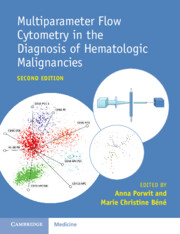Book contents
- Multiparameter Flow Cytometry in the Diagnosis of Haematologic Malignancies
- Multiparameter Flow Cytometry in the Diagnosis of Haematologic Malignancies
- Copyright page
- Contents
- Contributors
- Preface
- Abbreviations
- Chapter 1 Flow Cytometry in Clinical Haematopathology
- Chapter 2 Antigens
- Chapter 3 Flow Cytometry of Normal Blood, Bone Marrow and Lymphatic Tissue
- Chapter 4 Reactive Conditions and Other Diseases Where Flow Cytometric Findings May Mimic Haematological Malignancies
- Chapter 5 Examples of Immunophenotypic Features in Various Categories of Acute Leukaemia
- Chapter 6 Acute Lymphoid Leukaemia and Minimal/Measurable Residual Disease
- Chapter 7 Immunophenotyping of Mature B-Cell Lymphomas
- Chapter 8 Plasma Cell Myeloma and Related Disorders
- Chapter 9 Mature T-Cell Neoplasms and Natural Killer-Cell Malignancies
- Chapter 10 Flow Cytometric Diagnosis of Classic Hodgkin Lymphoma in Lymph Nodes
- Chapter 11 Measurable Residual Disease in Acute Myeloid Leukaemia
- Chapter 12 Ambiguous Lineage and Mixed Phenotype Acute Leukaemia
- Chapter 13 Flow Cytometry in Myelodysplastic Syndromes
- Chapter 14 Future Applications of Flow Cytometry and Related Techniques
- Index
- References
Chapter 2 - Antigens
Published online by Cambridge University Press: 30 January 2025
- Multiparameter Flow Cytometry in the Diagnosis of Haematologic Malignancies
- Multiparameter Flow Cytometry in the Diagnosis of Haematologic Malignancies
- Copyright page
- Contents
- Contributors
- Preface
- Abbreviations
- Chapter 1 Flow Cytometry in Clinical Haematopathology
- Chapter 2 Antigens
- Chapter 3 Flow Cytometry of Normal Blood, Bone Marrow and Lymphatic Tissue
- Chapter 4 Reactive Conditions and Other Diseases Where Flow Cytometric Findings May Mimic Haematological Malignancies
- Chapter 5 Examples of Immunophenotypic Features in Various Categories of Acute Leukaemia
- Chapter 6 Acute Lymphoid Leukaemia and Minimal/Measurable Residual Disease
- Chapter 7 Immunophenotyping of Mature B-Cell Lymphomas
- Chapter 8 Plasma Cell Myeloma and Related Disorders
- Chapter 9 Mature T-Cell Neoplasms and Natural Killer-Cell Malignancies
- Chapter 10 Flow Cytometric Diagnosis of Classic Hodgkin Lymphoma in Lymph Nodes
- Chapter 11 Measurable Residual Disease in Acute Myeloid Leukaemia
- Chapter 12 Ambiguous Lineage and Mixed Phenotype Acute Leukaemia
- Chapter 13 Flow Cytometry in Myelodysplastic Syndromes
- Chapter 14 Future Applications of Flow Cytometry and Related Techniques
- Index
- References
Summary
Flow cytometry relies on the use of fluorochrome-conjugated antibodies, most of them identified and produced after the discovery of the technology allowing to generate large amounts of monoclonal antibodies. Hence, nearly all these reagents are named after the cluster of differentiation (CD) number that was given to newly discovered molecules they recognize, many of them having no other name. Although some CDs have become very popular and well known, others are less familiar. This chapter provides a guide to recover the characteristics of surface or cytoplasmic antigens explored with the CDs most frequently used in the field of haematological malignancies.
Keywords
- Type
- Chapter
- Information
- Publisher: Cambridge University PressPrint publication year: 2025

